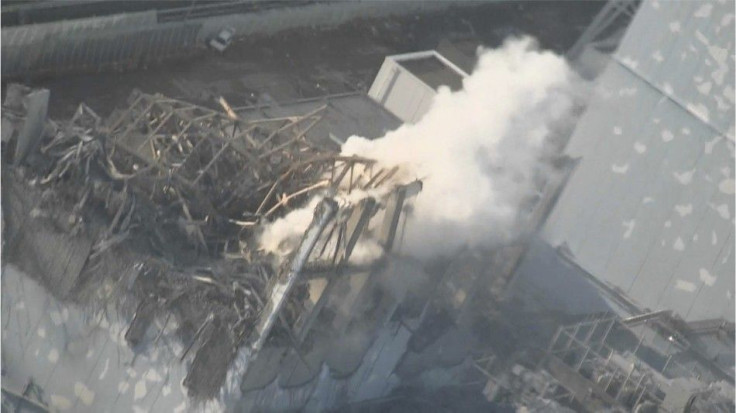IAEA update on Fukushima nuclear power plant

Summary of conditions at Fukushima Daiichi nuclear power plant, as described by the International Atomic Energy Agency (IAEA):
Located on the Eastern coast of Japan, the six nuclear power reactors at Daiichi are boiling water reactors (BWRs). A massive earthquake on 11 March severed off-site power to the plant and triggered the automatic shutdown of the three operating reactors - Units 1, 2, and 3. The control rods in those units were successfully inserted into the reactor cores, ending the fission chain reaction. The remaining reactors - Units 4, 5, and 6 -- had previously been shut down for routine maintenance purposes. Backup diesel generators, designed to start up after losing off-site power, began providing electricity to pumps circulating coolant to the six reactors.
Soon after the earthquake, a large tsunami washed over the reactor site, knocking out the backup generators. While some batteries remained operable, the entire site lost the ability to maintain proper reactor cooling and water circulation functions.
Here is the current status of the six reactors, based on documents and confirmed by Japanese officials (new information in bold):
Unit 1
Coolant within Unit 1 is covering about half of the fuel rods in the reactor, leading to fuel damage. High pressure within the reactor's containment led operators to vent gas from the containment. Later, an explosion destroyed the outer shell of the reactor building above the containment on 12 March.
There are no indications of problems with either the reactor pressure vessel or the primary containment vessel.
Efforts to pump seawater into the reactor core are continuing.
On 18 March, Japan assigned an INES rating of 5 to this unit. Further information on the ratings and the INES scale.
Unit 2
Coolant within Unit 2 is covering about half of the fuel rods in the reactor, leading to fuel damage. Following an explosion on 15 March, Japanese officials expressed concerns that the reactor's containment may not be fully intact. NISA officials reported on 18 March that white smoke continues to emerge from the building.
Efforts to pump seawater into the reactor core are continuing.
On 18 March, Japan assigned an INES rating of 5 to this unit.
Unit 3
Coolant within Unit 3 is covering about half of the fuel rods in the reactor, leading to fuel damage. High pressure within the reactor's containment led operators to vent gas from the containment. Later, an explosion destroyed the outer shell of the reactor building above the containment on 14 March.
Following the explosion, Japanese officials expressed concerns that the reactor's containment may not be fully intact. NISA officials reported on 18 March that white smoke continues to emerge from the building.
Efforts to pump seawater into the reactor core are continuing.
Of additional concern at Unit 3 is the condition of the spent fuel pool in the building. There are indications that there is an inadequate cooling water level in the pool, and Japanese authorities have addressed the problem by dropping water from helicopters into the building and spraying water from trucks. On 18 March, Japanese Self Defence Forces used seven fire trucks to continue spraying efforts. There is no data on the temperature of the water in the pool.
On 18 March, Japan assigned an INES rating of 5 to this unit.
Unit 4
All fuel had been removed from the reactor core for routine maintenance before the earthquake and placed into the spent fuel pool. A portion of the building's outer shell was damaged by the explosion at Unit 3 on 14 March, and there have been two reported fires - possibly including one in the spent fuel pool on 15 March -- that extinguished spontaneously, although smoke remained visible on 18 March.
Authorities remain concerned about the condition of the spent fuel pool.
On 18 March, Japan assigned an INES rating of 4 to this site.
Unit 5 and 6
Shut down before the earthquake, there are no immediate concerns about these reactors' cores or containment. Instrumentation from both spent fuel pools, however, has shown gradually increasing temperatures. Officials have configured two diesel generators at Unit 6 to power water circulation in the spent fuel pools and cores of Units 5 and 6.
Workers have opened holes in the roofs of both buildings to prevent the possible accumulation of hydrogen, which is suspected of causing explosions at other units.
Restoration of Grid
Progress has been achieved in restoring external power to the nuclear power plant, although it remains uncertain when full power will be available.
Evacuation
Japanese authorities have informed the IAEA that the evacuation of the population from the 20-kilometre zone around Fukushima Daiichi has been successfully completed. Japanese authorities have also advised people living within 30 kilometres of the plant to remain inside.
Iodine
On 16 March, Japan's Nuclear Safety Commission recommended local authorities to instruct evacuees leaving the 20-kilometre area to ingest stable (not radioactive) iodine. The pills and syrup (for children) had been prepositioned at evacuation centers. The order recommended taking a single dose, with an amount dependent on age:
Baby 12.5 mg
1 mo.-3 yrs. 25mg
3-13 yrs. 38mg
13-40 yrs. 76mg
40+ yrs. Not necessary
Radiation Measurements
Radiation levels near Fukushima Daiichi and beyond have elevated since the reactor damage began. However, dose rates in Tokyo and other areas outside the 30-kilometre zone remain far from levels which would require any protective action. In other words they are not dangerous to human health.
At the Fukushima Daiichi nuclear plant, radiation levels spiked three times since the earthquake, but have stabilized since 16 March at levels which are, although significantly higher than the normal levels, within the range that allows workers to continue onsite recovery measures.
© Copyright IBTimes 2024. All rights reserved.





















